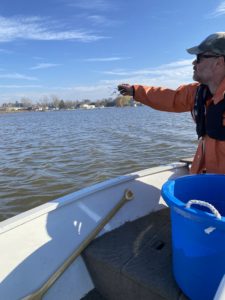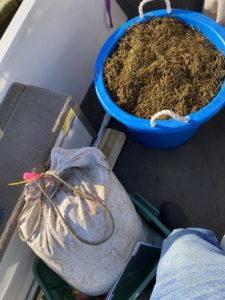 Some days things just line up the way they’re supposed to, and as a result something good gets done. That has happened on a number of days lately at Woodland Dunes, as we rush to finish field projects and outdoor education programs before the snow flies. Weather becomes more and more of a factor, and the coming winter adds a bit of urgency to our work, but we have been lucky lately.
Some days things just line up the way they’re supposed to, and as a result something good gets done. That has happened on a number of days lately at Woodland Dunes, as we rush to finish field projects and outdoor education programs before the snow flies. Weather becomes more and more of a factor, and the coming winter adds a bit of urgency to our work, but we have been lucky lately.Two things stand above all others at the nature center. They are- educating about nature, and restoring or improving habitat. Good weather helps us accomplish both. We still work when the weather is bad, but it is a bit harder to accomplish as much, or be as effective. But lately the weather has been good, and it shows.
Today was such a day. It was relatively warm, even in the early morning, temps in the upper 40’s. A southeast breeze was invigorating, scattering falling leaves and waving cattails in the marsh. As school children gathered in the yard to learn about owls, some of us prepared for planting. Not planting in our flower beds or grasslands, but out in the marsh along the West Twin River. Today is wild rice planting day.
Wild rice was found in much of the upper Midwest before Europeans came. Estuaries, those slow, marshy stretches at the mouths of rivers entering Lake Michigan, were good places for rice to grow. Milwaukee originally had a large marsh near the mouth of the rivers, populated with wild rice before it was developed and all the native habitat was replaced by buildings and wharfs. Such was undoubtedly the case here as well, and fortunately a marsh remains on the West Twin. Wild rice was an incredibly important food for native people. In fact, Ojibwe people came to the western Great Lakes because of wild rice- “the food that grows on the water”, or minoomin. What we’ve done to our rivers has not been good for wild rice, which has been replaced by plants which tolerate poorer water quality.
 Last year, Dr. Seilheimer from UW SeaGrant and myself ventured to wonder if wild rice might still grow here, and we obtained a small amount of seed for a trial planting. Early last November, we paddled out by canoe and scattered seed in areas where we thought growth might be possible. This summer, we were delighted to find rice growing in certain areas of the marsh, where vegetation filtered the water and improved its clarity and quality. This year, with the help of UW Green Bay and Ducks Unlimited, we were able to obtain more seed from the Mole Lake Band of Lake Superior Chippewa. We stored the seed submerged in a pond at the nature center until we were ready to plant. Then, with the help of two members of our Board of Directors, we were able to scatter seed in the marsh on this windy November morning, one group in a canoe and one in a fishing boat. In two hours we were able to disperse 200 lbs of seed, which quickly sinks to the mucky bottom. It lays there dormant and cold until spring. After germination it sends stringy leaves toward the surface, where they lay just below. In mid-summer they erupt out of the water, and in late summer flower and form seeds. In fall the seeds drop into the water, or are knocked into the water by feeding ducks, to begin the annual cycle over again.
Last year, Dr. Seilheimer from UW SeaGrant and myself ventured to wonder if wild rice might still grow here, and we obtained a small amount of seed for a trial planting. Early last November, we paddled out by canoe and scattered seed in areas where we thought growth might be possible. This summer, we were delighted to find rice growing in certain areas of the marsh, where vegetation filtered the water and improved its clarity and quality. This year, with the help of UW Green Bay and Ducks Unlimited, we were able to obtain more seed from the Mole Lake Band of Lake Superior Chippewa. We stored the seed submerged in a pond at the nature center until we were ready to plant. Then, with the help of two members of our Board of Directors, we were able to scatter seed in the marsh on this windy November morning, one group in a canoe and one in a fishing boat. In two hours we were able to disperse 200 lbs of seed, which quickly sinks to the mucky bottom. It lays there dormant and cold until spring. After germination it sends stringy leaves toward the surface, where they lay just below. In mid-summer they erupt out of the water, and in late summer flower and form seeds. In fall the seeds drop into the water, or are knocked into the water by feeding ducks, to begin the annual cycle over again.Now we will wait patiently to see if this enhanced planting is a success. It often takes five years of planting to produce beds of wild rice that are self sustaining- a lot of work for an aquatic grass. However, this is a plant that belongs here, and whose population can be restored. It is important as food for wildlife, and for thousands of years feed populations of people too. For those two reasons, we feel it is very important to at least attempt to recover a population of wild rice here. Doing so, we feel, would not only benefit the life of the marsh, which we hold important, but would also honor those people who lived here for so long and valued the land as do we.
So, we hope when you visit the nature center, and take a stroll out to the end of the Cattail Trail boardwalk, that next year and beyond you will see wild rice reaching out of the water, providing cover, and food, and balance to the marsh. And we hope it reminds you of all the life in the marsh and the river, and the lives of those who lived here before us.
Photos- Dr. Titus Seilheimer planting wild rice on the West Twin on November 3 2022
